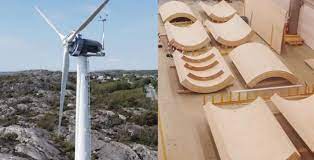Numerous construction projects that were previously off-limits to wood are now possible because to new techniques for connecting lumber together, most recently wind turbines.
Sweden, the home of wooden invention, is creating a 330-foot (100-meter) wooden wind turbine prototype to lessen the significant carbon impact of producing a wind turbine from steel.
But how can a building that is subjected to such force from gravity and wind be composed of something that a person might cut with a machete? The solution is laminated veneer lumber (LVL), a type of wood building material created by pressing together three-millimeter sheets of peeled spruce under extreme heat and pressure to produce flexible timber stronger than steel but lighter and less carbon-intensive.
The 130-foot (30-meter) prototype wind turbine tower was constructed in 2023 using LVL, which was produced by Stora Enso, one of the oldest timber enterprises in the world. Heavy curved LVL slabs are manufactured, brought to the construction site, and then cemented together to create the tall cylinder that will hold the spinning blades.
Wood may store carbon dioxide that trees have absorbed during their growth and reduce CO2 emissions from building a tower by 90%. The wood that is chosen for making LVL comes from mature trees that have already absorbed the most CO2 that is reasonably possible for them to absorb.
The wood used for advanced constructions such as wind turbine towers can be reused in new wood-based products which provides further long-term climate benefits by continuing to jail the carbon within their fibers.
Wood has a higher specific strength which enables a lighter construction. High steel towers need extra enforcement to carry their own weight—which wooden towers don’t need. And finally, modular steel towers demand a vast number of bolts that need regular inspections while our modular wooden towers are joined together with glue.
The towers would look about the same as a steel turbine, and not like a giant tree trunk due to an applied waterproof paint layer. At the moment, capturing carbon, done when the trees are turned into LVL, is more important than reducing emissions, since any reduction in emissions today won’t be felt in the global carbon cycle for far longer than any current predictions on warming or temperature changes. It’s only through actively taking emissions out of the cycle that are already there that humanity can change Earth’s climate.
Still, as long as humanity is building wind turbines to reduce emissions from energy use, we might as well reduce them from manufacturing too.




Recent Comments